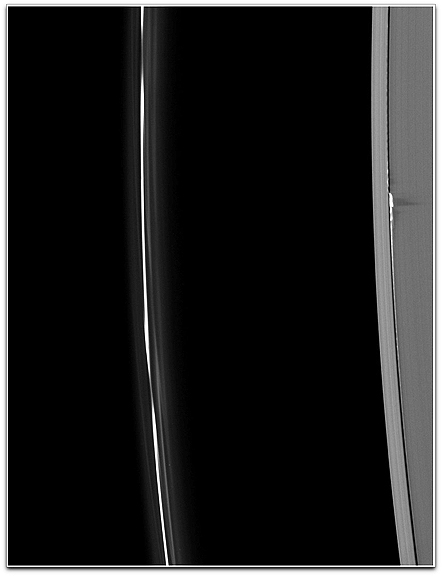NASA scientists are marveling over the extent of ruffles and dust clouds revealed in the rings of Saturn during the planet's equinox last month. Scientists once thought the rings were almost completely flat, but new images reveal the heights of some newly discovered bumps in the rings are as high as the Rocky Mountains. NASA released the images on Monday.

On August 11th, sunlight struck Saturn's rings exactly edge-on, performing a celestial magic trick that made them all but disappear. The spectacle occurs twice during each orbit Saturn makes around the sun, which takes approximately 10,759 Earth days, or about 29.7 Earth years. Earth experiences a similar equinox phenomenon twice a year; the
autumnal equinox will occur Sept. 22, when the sun will shine directly over Earth's equator. For about a week, scientists used the
Cassini orbiter to look at puffy parts of Saturn's rings caught in white glare from the low-angle lighting. Scientists have known about vertical clumps sticking out of the rings in a handful of places, but they could not directly measure the height and breadth of the undulations and ridges until Saturn's equinox revealed their shadows.
"The biggest surprise was to see so many places of vertical relief above and below the otherwise paper-thin rings," said
Linda Spilker, deputy project scientist at JPL. "To understand what we are seeing will take more time, but the images and data will help develop a more complete understanding of how old the rings might be and how they are evolving."
The chunks of ice that make up the main rings spread out 85,000 miles from the center of Saturn, but they had been thought to be only around 30 feet thick in the main rings, known as A, B, C, and D. In the new images, particles seemed to pile up in vertical formations in each of the rings. Rippling corrugations — previously seen by
Cassini to extend approximately 500 miles in the innermost D ring — appear to undulate out to a total of 11,000 miles through the neighboring C ring to the B ring. The heights of some of the newly discovered bumps are comparable to
the elevations of the Rocky Mountains. One ridge of icy ring
particles, whipped up by the gravitational pull of Saturn's moon
Daphnis as it travels through the plane of the rings, looms as high as 2.5 miles. It is the tallestvertical wall seen within the rings.
Topical Tags :
Regional Tags :

